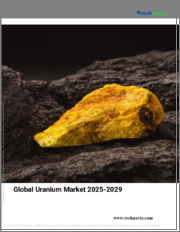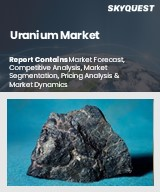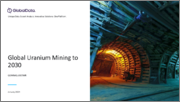
|
시장보고서
상품코드
1476388
우라늄 농축 시장 예측(-2030년) : 기술별, 용도별, 최종사용자별, 지역별 세계 분석Uranium Enrichment Market Forecasts to 2030 - Global Analysis By Technology (Gas Centrifuge, Gas Diffusion, Laser Enrichment, Plasma Separation and Other Technologies), Application, End User and By Geography |
||||||
Stratistics MRC에 따르면, 세계 우라늄 농축 시장은 2023년 190억 달러 규모이며, 예측 기간 동안 CAGR 10.0%로 성장하여 2030년에는 370억 달러에 달할 것으로 예상됩니다.
우라늄 농축은 천연 우라늄에서 우라늄 235 동위원소의 농도를 높이는 과정으로, 대부분 우라늄 238로 구성되어 있습니다. 우라늄235는 원자로와 무기에 사용되는 핵분열성 동위원소이며, 우라늄238은 이러한 목적에는 그다지 유용하지 않지만 또 다른 핵분열성 물질인 플루토늄239로 전환될 수 있습니다. 농축은 일반적으로 원심분리기와 우라늄235와 우라늄238의 미세한 질량 차이를 이용하는 다른 방법을 사용하여 이루어집니다. 이 과정을 통해 다양한 원자력 응용 분야에 필수적인 고농도의 우라늄 235를 함유한 농축 우라늄을 생산할 수 있습니다.
증가하는 원자력 수요
원자력 발전은 특히 재생 가능 자원에 대한 접근성이 제한적인 지역에서 청정 에너지 발전의 중요한 공급원이 되고 있습니다. 이러한 추세에 박차를 가하는 것은 원자력이 깨끗하고 신뢰할 수 있는 전력 공급원으로서, 특히 이산화탄소 배출량 감소 측면에서 원자력에 대한 인식이 높아지고 있다는 점입니다. 농축 기술의 발전과 각국의 원자력 발전 인프라 확대로 인해 향후 몇 년 동안 시장이 크게 성장할 것으로 예상됩니다.
핵확산 우려
원자력 에너지는 안전과 방사성 폐기물 처리에 대한 우려로 인해 여전히 국민들의 불안에 직면해 있습니다. 핵무기 확산은 안보 위험을 증가시키고 규제 당국의 압력을 가중시키고 있습니다. 이로 인해 우라늄 농축 기술에 대한 규제가 강화되고 시장 접근이 제한되고 있습니다. 또한, 지정학적 긴장은 시장 역학을 더욱 복잡하게 만들어 공급망과 투자 신뢰성에 영향을 미칩니다. 이처럼 핵확산은 시장에 큰 도전과제를 던져주고 있습니다.
핵의학 활용도 증가
우라늄 농축 공정을 통해 생산되는 방사성 동위원소에 의존하는 의료 진단 및 치료법의 발전으로 인해 이러한 추세는 더욱 가속화되고 있습니다. 표적 암 치료, 심혈관 영상, 신경학 연구에 대한 수요가 증가하면서 핵의학에 대한 수요가 크게 증가하고 있습니다. 이러한 변화는 농축 우라늄 시장이 전통적인 에너지 생산 이외의 다양하고 영향력 있는 용도로 전환하고 있음을 강조하며, 현대 의료 및 과학 연구에서 농축 우라늄의 다면적인 역할을 강조하고 있습니다.
재생에너지와의 경쟁
태양광, 풍력 등 재생에너지의 가격과 효율성이 향상되면서 원자력에 대한 경쟁 위협이 되고 있습니다. 재생에너지의 비용이 계속 하락하면 원자력과 농축 우라늄에 대한 수요가 감소할 수 있습니다. 기후변화에 대한 우려가 커지고 청정 대체 에너지에 대한 수요가 증가함에 따라 국가와 산업계는 재생에너지에 대한 대안 모색에 더욱 적극적으로 나서고 있습니다. 태양광 및 풍력 발전과 같은 재생에너지는 시장에서 점점 더 많은 경쟁을 유발하고 있습니다.
COVID-19의 영향:
COVID-19 사태는 시장에 큰 영향을 미쳤습니다. 많은 원자력 발전소가 가동 중단과 규제로 인해 가동을 축소하거나 유지보수를 실시하면서 농축 우라늄 수요가 감소했습니다. 공급망이 끊기면서 생산과 납품에 지연이 발생했습니다. 또한 원자력의 미래에 대한 불확실성은 우라늄 농축 분야에 대한 투자 및 확장 계획을 더욱 약화시켰습니다.
예측 기간 동안 가스 확산 부문이 가장 큰 비중을 차지할 것으로 예상됩니다.
예측 기간 동안 가스 확산 분야가 가장 큰 비중을 차지할 것으로 예상됩니다. 가스 확산법은 우라늄 동위원소 분리를 가능하게함으로써 우라늄 농축 시장에서 중요한 역할을 하고 있습니다. 이 공정은 우라늄 헥사플루오라이드 가스를 일련의 반투과성 막에 통과시켜 가벼운 U-235 동위원소를 밀도가 높은 U-238보다 더 빠르게 확산시킵니다. 이 기술은 역사적으로 농축 시설에서 사용되어 왔지만, 가스 원심분리기와 같은 새로운 기술은 그 효율성과 비용 효율성으로 인해 각광을 받고 있습니다.
예측 기간 동안 가장 높은 CAGR을 보일 것으로 예상되는 분야는 전력 부문입니다.
예측 기간 동안 가장 높은 CAGR을 기록할 것으로 예상되는 분야는 전력 부문입니다. 농축 시설은 첨단 원심분리기 기술과 가스 확산 방식을 사용하지만, 두 가지 모두 운영에 상당한 전력을 필요로 합니다. 전력 비용은 우라늄 농축의 경제성에 직접적인 영향을 미치며, 가격 전략과 시장 경쟁에 영향을 미칩니다. 또한, 에너지 효율이 높은 기술의 발전은 전력 비용을 절감하고 우라늄 농축 공정의 지속가능성을 높이기 위해 지속적으로 추구되고 있습니다.
가장 큰 점유율을 차지하는 지역
예측 기간 동안 북미가 가장 큰 시장 점유율을 차지할 것으로 예상됩니다. 이 지역의 주요 업체들은 농축 서비스의 주요 공급업체들입니다. 엄격한 규제 프레임워크와 기술 발전은 시장 성장을 촉진하고 안전하고 효율적인 농축 공정을 보장합니다. 지속가능한 에너지 솔루션에 초점을 맞춘 북미 우라늄 농축 시장은 지속적으로 발전하고 있으며, 이 지역의 에너지 안보에 크게 기여하고 있습니다.
CAGR이 가장 높은 지역:
예측 기간 동안 아시아태평양이 가장 높은 CAGR을 유지할 것으로 예상됩니다. 원심분리기 기술과 같은 농축 기술의 발전으로 인해 농축 공정이 더욱 효율적이고 비용 효율적이 되었습니다. 이 지역 국가들은 농축 능력을 강화하기 위해 이러한 첨단 기술에 투자하고 있습니다. 원자력 및 우라늄 농축을 둘러싼 규제 환경도 시장에 영향을 미칩니다. 원자력 안전, 핵 비확산 및 환경 문제와 관련된 엄격한 규제는 이 지역의 농축 시설 운영 및 확장 계획에 영향을 미칩니다.
무료 맞춤형 서비스:
이 보고서를 구독하는 고객은 다음과 같은 무료 맞춤화 옵션 중 하나를 사용할 수 있습니다.
- 기업 개요
- 추가 시장 기업의 종합적인 프로파일링(최대 3개사까지)
- 주요 기업 SWOT 분석(최대 3개사)
- 지역 세분화
- 고객의 관심에 따른 주요 국가별 시장 추정치, 예측, CAGR(주: 타당성 검토에 따른)
- 경쟁사 벤치마킹
- 제품 포트폴리오, 지리적 입지, 전략적 제휴를 기반으로 한 주요 기업 벤치마킹
목차
제1장 주요 요약
제2장 서문
- 개요
- 이해관계자
- 조사 범위
- 조사 방법
- 데이터 마이닝
- 데이터 분석
- 데이터 검증
- 조사 접근법
- 조사 정보 출처
- 1차 조사 정보 출처
- 2차 조사 정보 출처
- 가정
제3장 시장 동향 분석
- 성장 촉진요인
- 성장 억제요인
- 기회
- 위협
- 기술 분석
- 용도 분석
- 최종사용자 분석
- 신흥 시장
- COVID-19의 영향
제4장 Porter's Five Forces 분석
- 공급 기업의 교섭력
- 구매자의 교섭력
- 대체품의 위협
- 신규 참여업체의 위협
- 경쟁 기업 간의 경쟁 관계
제5장 세계의 우라늄 농축 시장 : 기술별
- 가스 원심분리기
- 가스 확산
- 레이저 인리치먼트
- 플라즈마 분리
- 기타 기술
제6장 세계의 우라늄 농축 시장 : 용도별
- 원자력발전
- 연구용 원자로
- 기타 용도
제7장 세계의 우라늄 농축 시장 : 최종사용자별
- 군용
- 전기
- 의료
- 산업
- 기타 최종사용자
제8장 세계의 우라늄 농축 시장 : 지역별
- 북미
- 미국
- 캐나다
- 멕시코
- 유럽
- 독일
- 영국
- 이탈리아
- 프랑스
- 스페인
- 기타 유럽
- 아시아태평양
- 일본
- 중국
- 인도
- 호주
- 뉴질랜드
- 한국
- 기타 아시아태평양
- 남미
- 아르헨티나
- 브라질
- 칠레
- 기타 남미
- 중동 및 아프리카
- 사우디아라비아
- 아랍에미리트
- 카타르
- 남아프리카공화국
- 기타 중동 및 아프리카
제9장 주요 발전
- 계약, 파트너십, 협업, 합작투자
- 인수와 합병
- 신제품 발매
- 사업 확대
- 기타 주요 전략
제10장 기업 개요
- Orano SA
- KazAtomProm
- GE Hitachi Nuclear Energy
- NAC Kazatomprom LLP
- China National Nuclear Corporation(CNNC)
- Tenex
- Cameco Corporation
According to Stratistics MRC, the Global Uranium Enrichment Market is accounted for $19.0 billion in 2023 and is expected to reach $37.0 billion by 2030 growing at a CAGR of 10.0% during the forecast period. Uranium enrichment is the process of increasing the concentration of uranium-235 isotopes in natural uranium, which mostly consists of uranium-238. Uranium-235 is the fissile isotope used in nuclear reactors and weapons, while uranium-238 is less useful for these purposes but can be converted into plutonium-239, another fissile material. Enrichment is typically done using centrifuges or other methods that exploit the slight difference in mass between uranium-235 and uranium-238. This process allows for the production of enriched uranium with higher concentrations of uranium-235, which is critical for various nuclear applications.
Market Dynamics:
Driver:
Growing demand for nuclear power
Nuclear power remains a significant source of clean energy generation, particularly in regions with limited access to renewable resources. This trend is fueled by the increasing recognition of nuclear energy as a clean and reliable source of electricity, especially in the context of reducing carbon emissions. With advancements in enrichment technologies and the expansion of nuclear power infrastructure in various countries, the market is poised for significant growth in the coming years.
Restraint:
Nuclear proliferation concerns
Nuclear energy still faces public apprehension due to concerns about safety and radioactive waste disposal. The proliferation of nuclear weapons heightens security risks and raises regulatory pressures. This translates into stringent controls on uranium enrichment technologies, limiting market accessibility. Additionally, geopolitical tensions further complicate market dynamics, affecting supply chains and investment confidence. Thus, nuclear proliferation presents formidable challenges within the market.
Opportunity:
Rising use of nuclear medicine
This trend is propelled by advancements in medical diagnostics and therapies that rely on radioisotopes produced through uranium enrichment processes. The growing demand for targeted cancer treatments, cardiovascular imaging, and neurological studies has significantly increased the adoption of nuclear medicine. This evolution underscores the market's shift towards diverse and impactful uses of enriched uranium beyond traditional energy production, highlighting its multifaceted role in modern healthcare and scientific research.
Threat:
Competition from renewables
The increasing affordability and efficiency of renewable energy sources like solar and wind power pose a competitive threat to nuclear power. If the cost of renewables continues to decline, it could dampen the demand for nuclear energy and enriched uranium. With growing concerns about climate change and the push for cleaner energy alternatives, countries and industries are exploring renewable options more aggressively. Renewable energy sources like solar and wind power are increasingly posing competition in the market.
Covid-19 Impact:
The COVID-19 pandemic had a significant impact on the market. Due to lockdowns and restrictions, many nuclear power plants reduced their operations or underwent maintenance, leading to decreased demand for enriched uranium. Supply chains were disrupted, causing delays in production and delivery. Additionally, uncertainties about the future of nuclear energy further dampened investment and expansion plans in the uranium enrichment sector.
The gas diffusion segment is expected to be the largest during the forecast period
The gas diffusion segment is expected to be the largest during the forecast period. The gas diffusion method plays a crucial role in the uranium enrichment market by enabling the separation of uranium isotopes. This process involves passing uranium hexafluoride gas through a series of semi-permeable membranes, allowing the lighter U-235 isotope to diffuse faster than the denser U-238. This technology has historically been used in enrichment facilities, although newer technologies like gas centrifuges have gained prominence due to their efficiency and cost-effectiveness.
The electricity segment is expected to have the highest CAGR during the forecast period
The electricity segment is expected to have the highest CAGR during the forecast period. Enrichment facilities utilize advanced centrifuge technology or gaseous diffusion methods, both of which demand substantial electrical input for operation. The cost of electricity directly impacts the economics of uranium enrichment, influencing pricing strategies and market competitiveness. Additionally, advancements in energy-efficient technologies are continually sought to mitigate electricity expenses and enhance the sustainability of uranium enrichment processes.
Region with largest share:
North America is projected to hold the largest market share during the forecast period. Key players in the region are leading suppliers of enrichment services. Stringent regulatory frameworks and technological advancements drive market growth, ensuring safe and efficient enrichment processes. With a focus on sustainable energy solutions, the North American uranium enrichment market continues to evolve, contributing significantly to the region's energy security.
Region with highest CAGR:
Asia Pacific is projected to hold the highest CAGR over the forecast period. Advancements in enrichment technologies, such as centrifuge technology, have made the enrichment process more efficient and cost-effective. Countries in the region are investing in these advanced technologies to enhance their enrichment capabilities. The regulatory environment surrounding nuclear energy and uranium enrichment also influences the market. Strict regulations related to nuclear safety, non-proliferation, and environmental concerns impact the operations and expansion plans of enrichment facilities in the region.
Key players in the market
Some of the key players in Uranium Enrichment market include Orano SA, KazAtomProm, GE Hitachi Nuclear Energy, NAC Kazatomprom LLP, China National Nuclear Corporation (CNNC), Tenex and Cameco Corporation.
Key Developments:
In September 2021, Orano SA announced a strategic partnership with the French Alternative Energies and Atomic Energy Commission (CEA) to collaborate on the development of new technologies for the decommissioning of nuclear facilities and the management of radioactive waste.
In March 2021, Cameco launched a new uranium product called the Blind River Refinery, which is a state-of-the-art uranium conversion facility located in Ontario, Canada. The facility aims to provide a reliable and sustainable supply of uranium products to the global market.
Technologies Covered:
- Gas Centrifuge
- Gas Diffusion
- Laser Enrichment
- Plasma Separation
- Other Technologies
Applications Covered:
- Nuclear Power Generation
- Research Reactors
- Other Applications
End Users Covered:
- Military
- Electricity
- Medical
- Industrial
- Other End Users
Regions Covered:
- North America
- US
- Canada
- Mexico
- Europe
- Germany
- UK
- Italy
- France
- Spain
- Rest of Europe
- Asia Pacific
- Japan
- China
- India
- Australia
- New Zealand
- South Korea
- Rest of Asia Pacific
- South America
- Argentina
- Brazil
- Chile
- Rest of South America
- Middle East & Africa
- Saudi Arabia
- UAE
- Qatar
- South Africa
- Rest of Middle East & Africa
What our report offers:
- Market share assessments for the regional and country-level segments
- Strategic recommendations for the new entrants
- Covers Market data for the years 2021, 2022, 2023, 2026, and 2030
- Market Trends (Drivers, Constraints, Opportunities, Threats, Challenges, Investment Opportunities, and recommendations)
- Strategic recommendations in key business segments based on the market estimations
- Competitive landscaping mapping the key common trends
- Company profiling with detailed strategies, financials, and recent developments
- Supply chain trends mapping the latest technological advancements
Free Customization Offerings:
All the customers of this report will be entitled to receive one of the following free customization options:
- Company Profiling
- Comprehensive profiling of additional market players (up to 3)
- SWOT Analysis of key players (up to 3)
- Regional Segmentation
- Market estimations, Forecasts and CAGR of any prominent country as per the client's interest (Note: Depends on feasibility check)
- Competitive Benchmarking
- Benchmarking of key players based on product portfolio, geographical presence, and strategic alliances
Table of Contents
1 Executive Summary
2 Preface
- 2.1 Abstract
- 2.2 Stake Holders
- 2.3 Research Scope
- 2.4 Research Methodology
- 2.4.1 Data Mining
- 2.4.2 Data Analysis
- 2.4.3 Data Validation
- 2.4.4 Research Approach
- 2.5 Research Sources
- 2.5.1 Primary Research Sources
- 2.5.2 Secondary Research Sources
- 2.5.3 Assumptions
3 Market Trend Analysis
- 3.1 Introduction
- 3.2 Drivers
- 3.3 Restraints
- 3.4 Opportunities
- 3.5 Threats
- 3.6 Technology Analysis
- 3.7 Application Analysis
- 3.8 End User Analysis
- 3.9 Emerging Markets
- 3.10 Impact of Covid-19
4 Porters Five Force Analysis
- 4.1 Bargaining power of suppliers
- 4.2 Bargaining power of buyers
- 4.3 Threat of substitutes
- 4.4 Threat of new entrants
- 4.5 Competitive rivalry
5 Global Uranium Enrichment Market, By Technology
- 5.1 Introduction
- 5.2 Gas Centrifuge
- 5.3 Gas Diffusion
- 5.4 Laser Enrichment
- 5.5 Plasma Separation
- 5.6 Other Technologies
6 Global Uranium Enrichment Market, By Application
- 6.1 Introduction
- 6.2 Nuclear Power Generation
- 6.3 Research Reactors
- 6.4 Other Applications
7 Global Uranium Enrichment Market, By End User
- 7.1 Introduction
- 7.2 Military
- 7.3 Electricity
- 7.4 Medical
- 7.5 Industrial
- 7.6 Other End Users
8 Global Uranium Enrichment Market, By Geography
- 8.1 Introduction
- 8.2 North America
- 8.2.1 US
- 8.2.2 Canada
- 8.2.3 Mexico
- 8.3 Europe
- 8.3.1 Germany
- 8.3.2 UK
- 8.3.3 Italy
- 8.3.4 France
- 8.3.5 Spain
- 8.3.6 Rest of Europe
- 8.4 Asia Pacific
- 8.4.1 Japan
- 8.4.2 China
- 8.4.3 India
- 8.4.4 Australia
- 8.4.5 New Zealand
- 8.4.6 South Korea
- 8.4.7 Rest of Asia Pacific
- 8.5 South America
- 8.5.1 Argentina
- 8.5.2 Brazil
- 8.5.3 Chile
- 8.5.4 Rest of South America
- 8.6 Middle East & Africa
- 8.6.1 Saudi Arabia
- 8.6.2 UAE
- 8.6.3 Qatar
- 8.6.4 South Africa
- 8.6.5 Rest of Middle East & Africa
9 Key Developments
- 9.1 Agreements, Partnerships, Collaborations and Joint Ventures
- 9.2 Acquisitions & Mergers
- 9.3 New Product Launch
- 9.4 Expansions
- 9.5 Other Key Strategies
10 Company Profiling
- 10.1 Orano SA
- 10.2 KazAtomProm
- 10.3 GE Hitachi Nuclear Energy
- 10.4 NAC Kazatomprom LLP
- 10.5 China National Nuclear Corporation (CNNC)
- 10.6 Tenex
- 10.7 Cameco Corporation
















